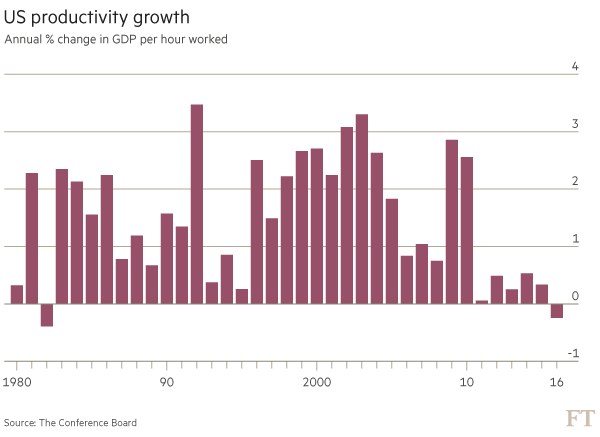Best of 2016: “US productivity slips for the first time in three decades”
Dieser Beitrag erschien zum ersten Mal am 8. Juni 2016 bei bto:
Immer wieder habe ich an dieser Stelle auf die Bedeutung von Demografie und Produktivitätsfortschritten verwiesen. Gerade Letztere sind seit Jahren enttäuschend und jede Hoffnung, durch einen Wachstumsschub der Überschuldung zu entgehen, ist eine Illusion:
→ Produktivitätszuwächse wären nett
→ Produktivitätsfortschritte: ja oder nein?
→ Ohne Produktivitätszuwächse: Inflation, stagnierende Löhne oder fallende Unternehmensgewinne
Nun berichtet die FT, dass zum ersten Mal seit drei Jahrzehnten die Produktivität der US-Wirtschaft gesunken ist. Wir haben also nicht nur geringere Zuwächse, nein, das Niveau sinkt! Dahinter steht natürlich, dass der Aufschwung seit 2009 vor allem schlecht bezahlte Jobs im Servicebereich geschaffen hat.
Quelle: FINANCIAL TIMES
Damit sind die USA schlechter als der Durchschnitt der Welt, wo im Jahre 2015 die Produktivität pro Kopf um 1,2 Prozent zugenommen hat, nach 1,9 Prozent im Jahre 2014. Sie sind sogar schlechter als die Eurozone (0,3 Prozent) und Japan (0,4 Prozent), wobei diese auch keine berauschenden Werte aufweisen!
Mit Blick auf die Schwellenländer hält die FT fest: „More recently even emerging economies have struggled to maintain the growth rates of the early years of this millennium, leading to a slowing of global productivity growth, which started around a decade ago and is becoming ever more worrisome.“
In China sank die Zuwachsrate von 5,2 auf 3,3 Prozent und es werden für 2016 3,6 Prozent erwartet. Das liegt deutlich unter dem Wert von sieben Prozent pro Jahr zwischen 2007 und 2013. Dies trifft China hart; es kämpft mit erheblichen Überkapazitäten und hoch verschuldeten „Zombie-Firmen“.
Quelle: FINANCIAL TIMES
Fazit: Die Politik des billigen Geldes hat Überkapazitäten und Fehlinvestitionen gefördert. Die Folge ist genau dieser Rückgang des Produktivitätswachstums.
So sieht es auch der Asset-Manager Black Summit: „The significant slowdown in the productivity growth rate translates into an inability to create and share wealth through jobs and income growth. As wealth creation fizzles out, the velocity of money, credit, and assets goes into a stage of atrophy. The dramatic measures by the central banks may have succeeded in rescuing bankrupt financial institutions and avoiding another Great Depression for the time being; however, they can do nothing to revitalize the velocity of money, assets, and credit.
As the graph below shows, the velocity of money (the rate at which money changes hands) has experienced a dramatic decline. An equal decrease could be observed in the velocity of collateral.
We are of the opinion that these trends are indicative of an economic and financial system which is unable to breathe and is on life support, expecting a new crisis that will turn things upside down and hopefully generate new lines and ways of thinking how wealth is created. The prosperity of any nation, corporation, or family does not depend upon its ability to consume or create debt instruments but rather on its ability to create and spread wealth.
The mountains of debt and unfunded liabilities created by collateralizing inflated and sometimes-questionable paper/financial assets are crying out that we are running out of space and time. The lack of investment spending, the deflationary threats, the unconventional monetary policies and so many other symptoms or policy responses indicate that policy makers may opt out by using fiscal spending which in turn will be monetized via helicopter money.
Investors will do well to start looking into asset classes that possess four characteristics they act as a shelter in inflationary pressures by retaining their value, provide a cash stream of income, have intrinsic value, and they can hedge the risks of a major crisis.“
→ FT (Anmeldung erforderlich): „US productivity slips for first time in three decades“, 25. Mai 2016










